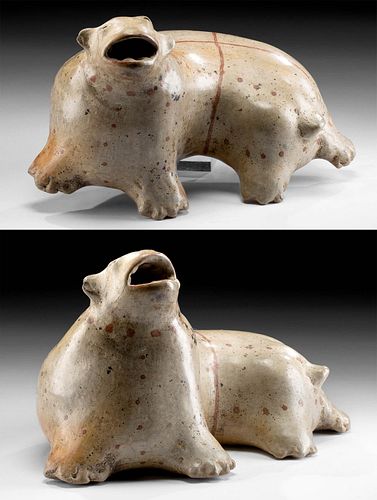Rare Nayarit Chinesco Pottery Sea Creature Vessel
Lot 202
About Seller
Artemis Fine Arts
686 S Taylor Ave, Ste 106
Louisville, CO 80027
United States
Selling antiquities, ancient and ethnographic art online since 1993, Artemis Gallery specializes in Classical Antiquities (Egyptian, Greek, Roman, Near Eastern), Asian, Pre-Columbian, African / Tribal / Oceanographic art. Our extensive inventory includes pottery, stone, metal, wood, glass and textil...Read more
Categories
Estimate:
$2,400 - $3,600
Absentee vs Live bid
Two ways to bid:
- Leave a max absentee bid and the platform will bid on your behalf up to your maximum bid during the live auction.
- Bid live during the auction and your bids will be submitted real-time to the auctioneer.
Bid Increments
| Price | Bid Increment |
|---|---|
| $0 | $25 |
| $300 | $50 |
| $1,000 | $100 |
| $2,000 | $250 |
| $5,000 | $500 |
| $10,000 | $1,000 |
| $20,000 | $2,500 |
| $50,000 | $5,000 |
| $100,000 | $10,000 |
| $200,000 | $20,000 |
About Auction
By Artemis Fine Arts
Mar 24, 2022
Set Reminder
2022-03-24 10:00:00
2022-03-24 10:00:00
America/New_York
Bidsquare
Bidsquare : Exceptional Antiquities Ethnographic Fine Art
https://www.bidsquare.com/auctions/artemis-gallery/exceptional-antiquities-ethnographic-fine-art-9057
Museum-worthy examples of classical antiquities (Egyptian, Greek, Roman, Near Eastern), Viking, Far East / Asian, Pre-Columbian, African / Tribal, Oceanic, Native American, Spanish Colonial, Fossils, Ancient Jewelry, Fine / Visual Arts, so much more! Artemis Fine Arts info@artemisfinearts.com
Museum-worthy examples of classical antiquities (Egyptian, Greek, Roman, Near Eastern), Viking, Far East / Asian, Pre-Columbian, African / Tribal, Oceanic, Native American, Spanish Colonial, Fossils, Ancient Jewelry, Fine / Visual Arts, so much more! Artemis Fine Arts info@artemisfinearts.com
- Lot Description
Pre-Columbian, West Mexico, Nayarit, Chinesco type, Protoclassic Period, ca. 100 BCE to 250 CE. A rare, heavy, and hollow pottery figural vessel of a sea creature. The mouth is ringed with flattened teeth, and the body has a petite tail and flippers. Red-painted details give spots and a lengthy cross design on the back and rings around the mouth. The interesting question, for interpreting the piece, is if it represents a true animal, a mythical creature, or some kind of transformative figure, half real, half myth? The presence of ears suggest that this is a representation of the Guadalupe fur seal, known from Mexico's Pacific Coast. The Nayarit, like other ancient cultures, were most likely keen observers of nature and may have hunted the seals that washed up on their shores. However, the lack of "fingers" on the flippers (there are five "fingers" on the back flippers of a true fur seal) and the strange teeth (seals have large canines) are not realistic and therefore suggest some element of monstrosity or transformation to the sculpture. Size: 12.5" W x 6.75" H (31.8 cm x 17.1 cm)
This style of sculpture is known as Chinesco by collectors because of its stylistic similarities to some forms of Chinese art. Pottery figural vessels like this one are the only remains that we have today of a sophisticated and unique culture in West Mexico -- they made no above-ground monuments or sculptures, at least that we know of, which is in strong contrast to developments elsewhere in ancient Mesoamerica. Instead, their tombs were their lasting works of art: skeletons arrayed radially with their feet positioned inward, and clay offerings - like this one - placed alongside the walls facing inward, near the skulls. A large effigy vessel like this one would most likely have flanked the entrance to a tomb in a way that archaeologists have interpreted as guarding. Some scholars have connected these dynamic sculptures of the living as a strong contrast to the skeletal remains whose space they shared, as if they mediated between the living and the dead.
Provenance: private Hidden Valley Lake, California, USA collection, acquired from Artemis Gallery in April 2020; ex-private Huber collection, Dixon, Illinois, USA, collected prior to 1980
All items legal to buy/sell under U.S. Statute covering cultural patrimony Code 2600, CHAPTER 14, and are guaranteed to be as described or your money back.
A Certificate of Authenticity will accompany all winning bids.
PLEASE NOTE: Due to recent increases of shipments being seized by Australian & German customs (even for items with pre-UNESCO provenance), we will no longer ship most antiquities and ancient Chinese art to Australia & Germany. For categories of items that are acceptable to ship to Australia or Germany, please contact us directly or work with your local customs brokerage firm.
Display stands not described as included/custom in the item description are for photography purposes only and will not be included with the item upon shipping.
#170501Restoration to outer half of proper left ear, with resurfacing and overpainting along new material and break lines. One stable but branching hairline fissures stemming from right corner of mouth. Small chips to some toes, with light abrasions and fading to original pigment, and light pitting in some areas. Great preservation of original pigment, with nice manganese deposits throughout. Old inventory labels beneath body.Condition
- Shipping Info
-
All shipping is handled in-house for your convenience. Your invoice from Artemis Gallery will include shipping calculation instructions. If in doubt, please inquire BEFORE bidding for estimated shipping costs for individual items.
-
- Buyer's Premium



 EUR
EUR CAD
CAD AUD
AUD GBP
GBP MXN
MXN HKD
HKD CNY
CNY MYR
MYR SEK
SEK SGD
SGD CHF
CHF THB
THB
















